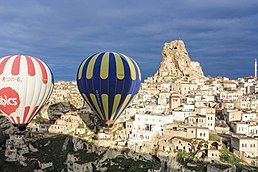Cappadocia | |
|---|---|
Ancient region of Central Anatolia Region, Turkey | |
Clockwise from top: Ortahisar Castle, View of Uçhisar Castle, Mount Erciyes, Rose Valley, Ihlara Valley, Göreme Open Air Museum, Aerial view over Cappadocia | |
 Cappadocia among the classical regions of Anatolia (Asia Minor) | |
| Coordinates: 38°39′30″N 34°51′13″E / 38.65833°N 34.85361°E | |
| Persian satrapy | Katpatuka |
| Roman province | Cappadocia |
| UNESCO World Heritage Site | |
|---|---|
 | |
| Includes | Göreme National Park, Kaymakli Underground City, Derinkuyu underground city |
| Criteria | Cultural: i, iii, v; Natural: vii |
| Reference | 357 |
| Inscription | 1985 (9th Session) |
| Area | 9,883.81 ha |
Cappadocia (/kæpəˈdoʊʃəˌ -ˈdoʊkiə/; Turkish: Kapadokya, Greek: Καππαδοκία) is a historical region in Central Anatolia, Turkey. It is largely in the provinces of Nevşehir, Kayseri, Aksaray, Kırşehir, Sivas and Niğde.
According to Herodotus,[1] in the time of the Ionian Revolt (499 BC), the Cappadocians were reported as occupying a region from Mount Taurus to the vicinity of the Euxine (Black Sea). Cappadocia, in this sense, was bounded in the south by the chain of the Taurus Mountains that separate it from Cilicia, to the east by the upper Euphrates, to the north by Pontus, and to the west by Lycaonia and eastern Galatia.[2]
The name, traditionally used in Christian sources throughout history, continues in use as an international tourism concept to define a region of exceptional natural wonders, in particular characterized by fairy chimneys,[3] in addition to its religious heritage of being a centre of early Christian learning, evidenced by hundreds of churches and monasteries (such as those of Göreme and Ihlara), as well as underground cities that were dug to offer protection during periods of persecution.[4][5]
- ^ [Herodotus, The Histories, Book 5, Chapter 49]
- ^ Van Dam, R. Kingdom of Snow: Roman rule and Greek culture in Cappadocia. Philadelphia: University of Pennsylvania Press, 2002, p.13. [1]
- ^ Demir, Ömer (1997). Cappadocia: Cradle of History. 16: Azim Matbaacılık. p. 15.
History, nature and mankind have created many important wonders in Cappadocia: 1- The unique natural landscape, include fairy chimneys, rock formations and valleys. 2- The rock-hewn churches decorated with frescoes from the 6th-12th C of scenes from the Bible, especially the lives of Jesus, Mother Mary and saints. 3- The undergound settlements many consider to by the 8th wonder of the ancient world.
{{cite book}}: CS1 maint: location (link) - ^ Demir, Ömer (1997). Cappadocia: Cradle of History. 16: Azim Matbaacılık. pp. 11–15, 70.
{{cite book}}: CS1 maint: location (link) - ^ Demir, Ömer (1997). Cappadocia: Cradle of History. 16: Azim Matbaacılık. p. 70.
However, the longest working and living period was the century when underground cities in Cappadocia were dug by Christians who could not bear Arabic and Sassanid threat after Capadocia was conquered … It is clearly visible in some underground cities in Cappadocia that the rooms located near the entrance are profoundly different from those that are inside. Saratli and Özlüce underground cities are given as an example regarding these differences.
{{cite book}}: CS1 maint: location (link)






